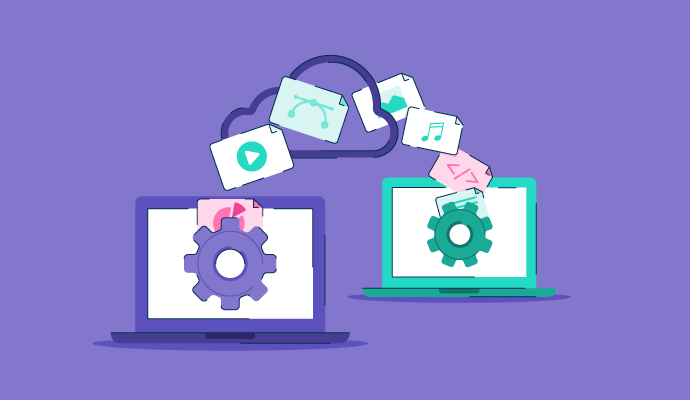The world has been an eyewitness to the tech revolution. So, the days of "copy" and "paste" are behind us.
Agile project management has taken the corporate world by storm, as collaborative, flexible production within teams has proven to be the most important business strategy in recent years. One such application software technique that witnessed change was the way to transfer files from PC to PC.
With big tech terms like the Internet of Things, quantum computing, and virtual reality, it's safe to say that businesses are stuck inside a closet. By introducing new-age tech, standard file-sharing operations can be done in seconds.
Transferring files to external servers might warrant unsecured and unprotected networks. Using file transfer protocol software will help monitor networking protocols as and when you make the transfer and route the files to the destination without firewall interruptions.
How to transfer files from PC to PC
To transfer files from close-end servers to open-end servers or different internal workstations, follow the following process.
- Direct file transfer (flash drive, email, network file transfer, SCP/SSH)
- Cloud storage and transfer software
- SFTP (secure file transfer protocol) and MFT(managed file transfer) tools
- File migration software
When it comes to file transfers, you have four main options, all dependent on what you need to transfer, how secure you need the transfer to be, and its priority.
All these options can be performed on any operating system—Windows, Mac OS X, Linux, etc.—but at certain points, they may require different software assistance.
Let’s work through these transfer methods by relative complexity, beginning with the simplest.
Method 1: Direct file transfer
Direct file transfer is probably the easiest way to send files from one place to another. As the name states, it involves moving a file directly from one device to another with little to no software intermediation.
Some examples of this method are:
- Flash drive
- Network file transfer
- SCP/SSH
- Remote desktop and remote support software
Transferring files with flash drives
While flash drives are about as direct as direct can be, they also have the potential to be the most insecure. If the flash drive isn’t properly encrypted or password-protected, and that flash drive falls into the wrong hands, whoever has it now has access to those files. The same can be said for using a transfer cable or any other external drive.
Regardless, this method is relatively simple. Just insert the flash drive into the USB slot of your computer, find the device within file explorer, drag the files onto the folder of the flash drive, remove the drive from your device and insert it into the other PC.
Transferring files through email
Email can be a more secure option to send files from one place to another. It’s also a basic option that everyone has access to every day, making it significantly more convenient.
However, there are some drawbacks to using email. Aside from potential encryption troubles, the main drawback is that email file transfer has some restrictions when it comes to attachment size. Most email services don’t allow attachments above 10 megabytes, and while you may not be transferring 1,000-plus pages of text documents, 10 megabytes is a very small size for most media files.
Transferring files using network file transfer
From here, direct network transfer depends on convenience.
For two computers on the same internal network (such as two laptops on the same Wi-Fi network) or in proximity (using Bluetooth), network file transfer from one device to another can be very convenient, though somewhat time-consuming.
Both devices would need to be visible to each other either on the network or via Bluetooth. Once the devices are discoverable, you can select to transfer files from one device to another by sharing, copying/pasting, clicking and dragging, etc. This takes time to complete because you’re copying directly over a network. You can also utilize network drives that all users on a single internet network can store and retrieve from directly.
Transferring files using SCP/SSH
SCP/SSH (Secure Copy Protocol/Secure Shell) is the most complicated direct transfer option.
Using the shell on your computer (“command prompt” or “cmd” on Windows, “terminal” on Mac OS, “bash” on Linux), connect to the device where the files you need are located. Then, call the file location and file name and use a copy command to pull the file.
This method is complicated and not recommended unless you are familiar with the shell of a computer. It’s also not useful when at home, but it can be extremely useful for remotely pulling files off of servers.
Transferring files using remote software
It should be noted that most remote desktop and remote support software come with built-in file transfer functionality. IT support analysts, in particular, can greatly benefit from this function, as they can move .ini files, .dll files, scripts, and even executables (.exe) from computer to computer to assist in troubleshooting and issue resolution.
Top remote desktop software
These are the top five leading software solutions from G2’s Summer 2024 Grid® Report.
The video below explains how to directly transfer files between Windows computers.
Source: Plugable
Quer aprender mais sobre Software de Transferência Gerenciada de Arquivos (MFT)? Explore os produtos de Transferência Gerenciada de Arquivos (MFT).
Method 2: Cloud storage and transfer
The advent of cloud computing and cloud storage has made it significantly easier to store and access files wherever you need them. Because of this, it’s also significantly easier to transfer files from one place to another using a cloud intermediary.
Cloud storage is prevalent and has now been adopted by numerous businesses to make file access and sharing simpler. Once a file is saved to cloud file storage and sharing software, there’s usually a way to either transfer it directly to another user or send that user a URL that they can use to download the file.
This is a quick, easy way to transfer files from one place to another, but it comes with a slight bottleneck. Most cloud storage and transfer solutions have storage limits unless you upgrade your subscription.
If you’re looking to store and move huge volumes of data, it’s in your best interest to make sure the solution you choose is within your budget and meets your file sharing needs.
Top cloud content collaboration software
These are the top five leading cloud content collaboration software solutions from G2’s Summer 2024 Grid® Report.
Now is the time to get SaaS-y news and entertainment with our 5-minute newsletter, G2 Tea, featuring inspiring leaders, hot takes, and bold predictions. Subscribe below!
Method 3: SFTP/MFT tools
Depending on the type of files being sent, it can be critical that the file transfer is both secure and encrypted.
When sharing sensitive information—such as PHI (protected health information), PII (personally identifiable information like an SSN), or financial information—in a file, it is highly recommended to use a secure file transfer protocol (SFTP). This is a highly secure file transfer method called managed file transfer (MFT).
MFT is built off of FTP (file transfer protocol), a kind of direct file transfer method, but it’s more involved and significantly more protected than standard direct file transfer. SFTP and MFT are go-to picks for any heavily regulated industry, like healthcare or finance. If you’re in the European Union, MFT is great for helping your company maintain GDPR compliance.
SFTP and other MFT tools are particularly useful for pulling information from data servers and archives, but they’re also useful for securely transferring files from one site to another or from one business network to another.
This kind of transfer is significantly more secure through SFTP and/or MFT. These tools can also be applied to financial industry data, legal industry data, and other confidentiality-based industries’ data.
Top managed file transfer software
These are the top five leading file transfer software solutions from G2’s Summer 2024 Grid® Report.
Method 4: File migration
Unlike other file transfer methods, file migration software tends to be used for a more specific purpose. File migrations are generally large-scale, enterprise-level file relocations. That is, you’re transferring more than just a few files from one computer to another — you’re relocating the entirety of your company’s files from one storage location to another.
To accomplish this large and cumbersome task, file transfer has to be secure and able to handle massive amounts of data. File migration is usually measured not in megabytes or gigabytes but in terabytes or petabytes of data since the data managed is company-wide and not at an individual level.
Important to consider that file migration tools tend to care about the kind of file formats they migrate. While some file migration tools (namely in the cloud migration software realm) don’t necessarily aim for a specific software class, some may specialize in a certain type of data like email or even data on a specific software tool.
Top cloud migration platforms
These are the top five leading cloud migration software solutions from G2’s Summer 2024 Grid® Report.
It’s okay to overshare
Whether you’re sharing files with coworkers, sending pictures to a friend, or transferring files from your old computer to a new one, you have options.
Whether you choose the old-fashioned way of a flash drive or decide to go with innovative software, your files will be easily accessible from any device, anywhere.
Learn how to set up a hardware wallet to secure your digital assets for seamless monetization.
This article was originally published in 2023. It has been updated with new information.

Zack Busch
Zack is a former G2 senior research analyst for IT and development software. He leveraged years of national and international vendor relations experience, working with software vendors of all markets and regions to improve product and market representation on G2, as well as built better cross-company relationships. Using authenticated review data, he analyzed product and competitor data to find trends in buyer/user preferences around software implementation, support, and functionality. This data enabled thought leadership initiatives around topics such as cloud infrastructure, monitoring, backup, and ITSM.


